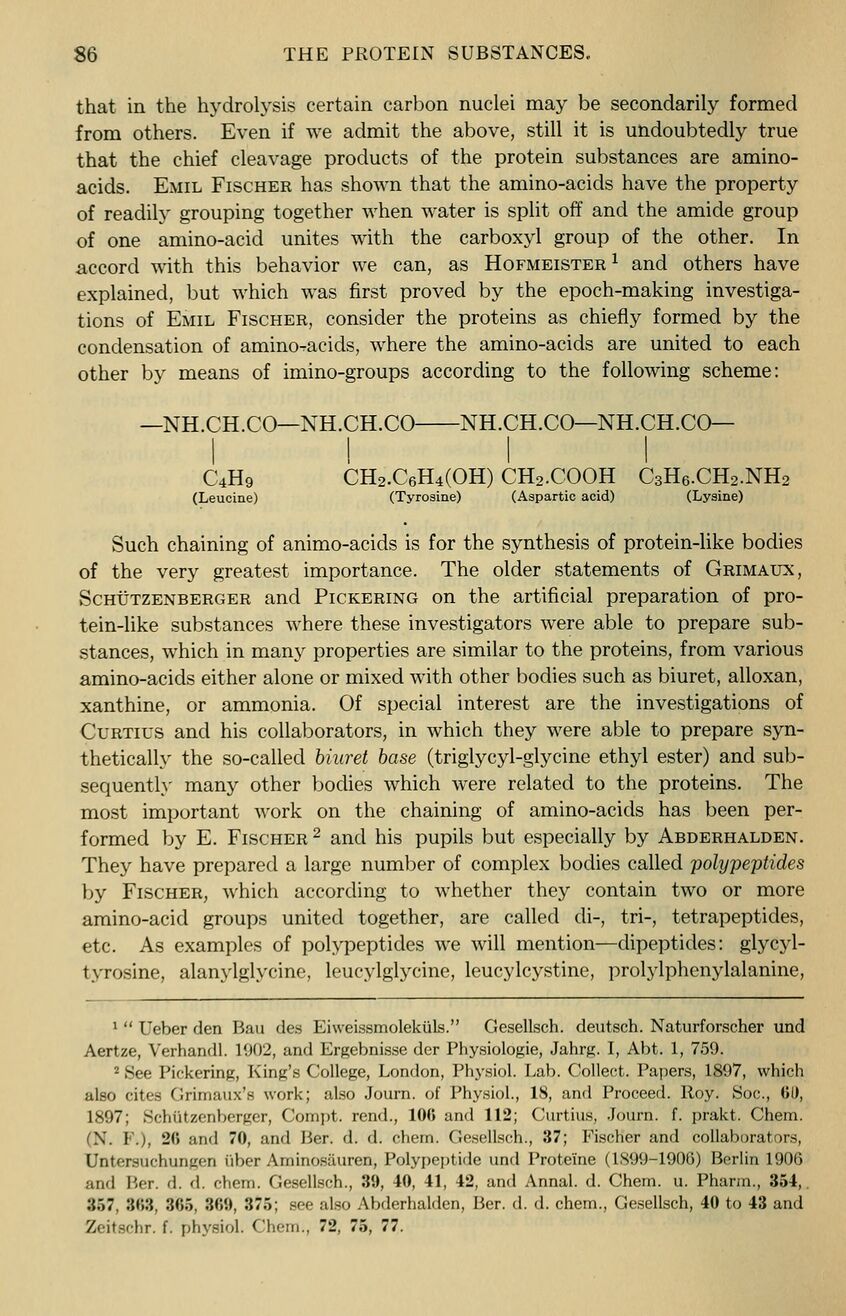
Full resolution (JPEG) - On this page / på denna sida - II. The Protein Substances

<< prev. page << föreg. sida << >> nästa sida >> next page >>
Below is the raw OCR text
from the above scanned image.
Do you see an error? Proofread the page now!
Här nedan syns maskintolkade texten från faksimilbilden ovan.
Ser du något fel? Korrekturläs sidan nu!
This page has never been proofread. / Denna sida har aldrig korrekturlästs.
86 THE PROTEIN SUBSTANCES,
that in the hydrolysis certain carbon nuclei may be secondarily formed
from others. Even if we admit the above, still it is undoubtedly true
that the chief cleavage products of the protein substances are amino-
acids. Emil Fischer has shown that the amino-acids have the property
of readily grouping together when water is split off and the amide group
of one amino-acid unites with the carboxyl group of the other. In
accord with this behavior we can, as Hofmeister 1
and others have
explained, but which was first proved by the epoch-making investiga-
tions of Emil Fischer, consider the proteins as chiefly formed by the
condensation of aminoTacids, where the amino-acids are united to each
other by means of imino-groups according to the following scheme:
—NH.CH.CO—NH.CH.CO NH.CH.CO—NH.CH.CO—
C4H9 CH2 .C6H4 (OH) CH2.COOH C3He.CH2.NH2
(Leucine) (Tyrosine) (Aspartic acid) (Lysine)
Such chaining of animo-acids is for the synthesis of protein-like bodies
of the very greatest importance. The older statements of Grimaux,
Schutzenberger and Pickering on the artificial preparation of pro-
tein-like substances where these investigators were able to prepare sub-
stances, which in many properties are similar to the proteins, from various
amino-acids either alone or mixed with other bodies such as biuret, alloxan,
xanthine, or ammonia. Of special interest are the investigations of
Curtius and his collaborators, in which they were able to prepare syn-
thetically the so-called biuret base (triglycyl-glycine ethyl ester) and sub-
sequently many other bodies which were related to the proteins. The
most important work on the chaining of amino-acids has been per-
formed by E. Fischer 2
and his pupils but especially by Abderhalden.
They have prepared a large number of complex bodies called polypeptides
by Fischer, which according to whether they contain two or more
amino-acid groups united together, are called di-, tri-, tetrapeptides,
etc. As examples of polypeptides we will mention—dipeptides: glycyl-
tvrosine, alanylglycine, leucylglycine, leucylcystine, prolylphenylalanine,
1 " Ueber den Bau des Eiweissmolekiils." Gesellsch. deutsch. Naturforscher und
Aertze, Verhandl. 1902, and Ergebnisse der Physiologie, Jahrg. I, Abt. 1, 759.
See Pickering, King’s College, London, Physiol. Lab. Collect. Papers, 1897, which
also cites Grimaux’e work; also Journ. of Physiol., 18, and Proceed. Roy. Soc, 60,
1897; Schutzenberger, Compt. rend., 100 and 112; Curtius, Journ. f. prakt. Chem.
(N. li. 26 and 70, and Per. d. d. chem. Gesellsch., 37; Fischer and collaboral >rs,
Untersuchungen iiber Aminosauren, Polypeptide und Proteine (1S99-1906) Berlin 190G
and 1’ir. d. d. chern. Gesellsch., 39, 40, 41, 42, und Annal. d. Chem. u. Pharm., 354,.
:{.")7. :{<;:{. :{C>r>. :{*;*.>, 37."); see also Abderhalden, Ber. d. d. chem., Gesellsch, 40 to 43 and
Zeitschr. f. physiol. Chem., 72, 75, 77.
<< prev. page << föreg. sida << >> nästa sida >> next page >>